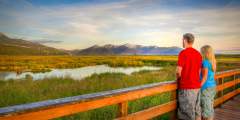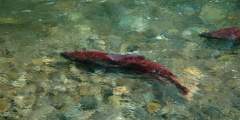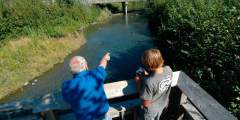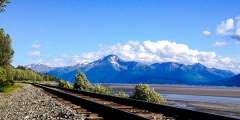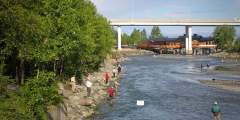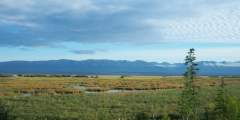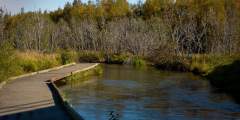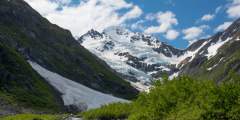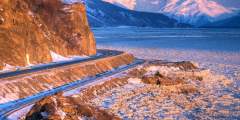The Best Salmon Viewing Spots in Anchorage
All five species of Pacific salmon converge on Anchorage streams each summer, sometimes in spectacular numbers. And they’re easy to view—whether you seek feisty chinooks as long as human’s arm in spring, or dense congregations of humpies during the summer peak, or the last, lingering cohos after the first frost.
Some of the best viewing spots are right in the urban area with easy access to overlooks. Others are short drives from town, especially along Turnagain Arm.
- Ship Creek Dam. For glimpses of the big king or Chinook salmon right inside the city’s industrial heart, check out the hatchery-seeded run at Ship Creek from late May into August. Some of the best viewing can be found in the clear water at the spillway and fish ladders at the Ship Creek Overlook Park off East Whitney Road, in the railroad and warehouse basin north of downtown.
- William Jack Hernandez Sport Fish Hatchery. For both indoor and outdoor viewing of big kings (plus cohos in August), go two miles upstream to the William Jack Hernandez Sports Fish Hatchery, at the corner of Post Road and Reeve Boulevard, and take the self-guided tour.
- Potter Marsh. Multiple species swirl beneath the boardwalks at Potter Marsh in the Anchorage Coastal Wildlife Refuge in South Anchorage. For best fish viewing, take the right-hand (highway oriented) boardwalk to where it crosses Rabbit Creek. By midsummer, you might see Chinook, coho and humpback salmon swirling in the same pool.
- Indian Creek. To experience the classic coastal pink salmon run—sometimes with hundreds of fish practically jamming the stream—check out Indian Creek about 24 miles south along the Seward Highway in August. It’s intimate and fascinating!
- Williwaw Fish Viewing Platform. Crystal-clear Williwaw Creek and its bank-side trail system in Portage Valley at the head of Turnagain Arm offers exceptionally good conditions for watching spawning in action. Coho, sockeye and chum salmon converge on the creek as it winds through the brushy flats beginning in mid-August, with some late-arriving fish still present after first frost in the fall.
For much more detail, check out detailed run-timing charts by region posted by state biologists or Alaska.org’s primer on Best Time to Fish.
A quick cheat sheet for salmon lovers:
- Chinooks—mid-May to early July.
- Sockeyes—June to July
- Chums—late July to August
- Humpies—July to August
- Cohos—July to October
Show Map
Salmon Viewing Spots
Here you’ll find one of the most accessible wildlife viewing areas in Alaska. The marsh is a rest area for migratory birds including trumpeter swans, rednecked grebes, golden eyes, and pintails. Also watch for beavers, moose and bald eagles. You may even spot salmon spawning in the deeper water.
If you want to marvel at the sight of thousands of fish schooling in gigantic tanks, take the self-guided tour inside the state fish hatchery on the banks of Ship Creek east of downtown. The museum-quality observation deck offers intimate views of a complex operation that produces up to six million sport fish each year.
Crystal-clear Williwaw Creek and its bank-side trail system in Portage Valley at the head of Turnagain Arm offers exceptionally good conditions for watching spawning in action. Coho, sockeye and chum salmon converge on the creek as it winds through the brushy flats beginning in mid-August, with some late-arriving fish still present after first frost in the fall.
Thousands of pink salmon converge on Indian Creek each July and August, just about filling this shallow, easy-flowing stream south of Anchorage along Turnagain Arm from bank-to-bank. This amazing natural spectacle occurs in one of the easiest places to view spawning salmon in the region: No steep banks, crystal clear water and fish so close they could almost be touched.
For glimpses of the big Chinook salmon right inside the city’s industrial heart, check out the hatchery-seeded run at Ship Creek between late May into June. Hatchery-seeded coho salmon begin running through the same waters in late July through August.
Visible outside the windows of the Mat-Su Convention and Visitors Bureau, this state wildlife refuge is the result of the 1964 earthquake. Literally overnight, the land dropped by 6 to 20 feet; hay fields and pastureland became salt flats and marshland. Once home to cows and grains, the land is now prime habitat for moose, birds, and fish. Some 20,000 acres are protected in the refuge, which is a popular recreation and wildlife-viewing… ...more
This 64.3 acre park has lots to offer with open fields, skijoring trails, a sledding hill, one soccer field, fishing during designated seasons, and a fish viewing platform that is best during the mid to late summer.
Portage Valley southeast of Anchorage at the head of Turnagain Arm offers so many potential adventures that you might have to tow a trailer loaded with gear to sample them all. What will you find here? Biking, hiking, picnicking, fishing, paddling, wildlife viewing, potential iceberg sightings — plus a natural history visitor center packed with interactive displays about the ecosystem of the valley and Prince William Sound. It’s like an outdoor ...more
The drive from Anchorage to the seaside community of Seward begins with two hours of spectacular views as you pass between the dramatic shorelines of Turnagain Arm and the jutting peaks of the Chugach Mountains.

